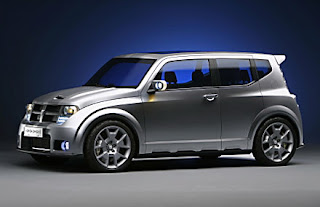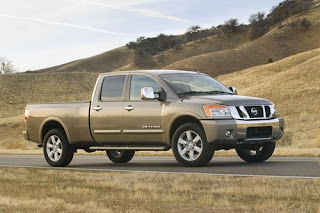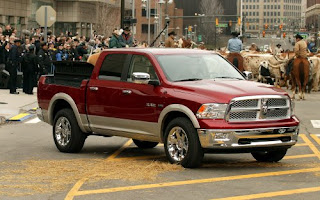Chrysler Figures Out How to Make Good Cars and Nissan Figures Out How to Make Good Trucks
Significantly expanding the product sharing agreement announced a this past January for Nissan to produce a version of its Tiida (Versa) for Chrysler to sell in the South American market, Chrysler and Nissan jointly announced today that they have expanded their product sharing relationship pretty significantly.
 Chrysler is getting a small car, to be built on a new Nissan platform and based on a vehicle that Chrysler has “already designed,” will be assembled at Nissan’s plant in Oppama, Japan. Although Chrysler Vice Chairman Tom LaSorda would not confirm which specific product they had in mind, speculation is that the small car might finally be the Dodge Hornet subcompact, first shown as a concept at the Geneva auto show in 2006. At the time of its public debut, DaimlerChrysler executives claimed that they were searching for a partner to build the car, but the concept was well-received by the media and public. Once Chrysler entered into a partnership with China’s Chery, it was assumed that Chery would build the car for Chrysler, and become one of the first Chinese-built mass-market vehicles sold in the US. Since LaSorda would not confirm or deny whether the Hornet is the car that Nissan will build for Chrysler, it remains an open question whether the Nissan-built car will be the Hornet or something completely different. Whatever vehicle it is, it’s indisputable that Chrysler is in desperate need of small cars in its lineup (the smallest Dodge at the moment is the husky Caliber), so in a world of $4 per gallon fuel prices, having two stylish subcompacts would be a better place for Chrysler to be than with eleven SUVs as they currently have.
Chrysler is getting a small car, to be built on a new Nissan platform and based on a vehicle that Chrysler has “already designed,” will be assembled at Nissan’s plant in Oppama, Japan. Although Chrysler Vice Chairman Tom LaSorda would not confirm which specific product they had in mind, speculation is that the small car might finally be the Dodge Hornet subcompact, first shown as a concept at the Geneva auto show in 2006. At the time of its public debut, DaimlerChrysler executives claimed that they were searching for a partner to build the car, but the concept was well-received by the media and public. Once Chrysler entered into a partnership with China’s Chery, it was assumed that Chery would build the car for Chrysler, and become one of the first Chinese-built mass-market vehicles sold in the US. Since LaSorda would not confirm or deny whether the Hornet is the car that Nissan will build for Chrysler, it remains an open question whether the Nissan-built car will be the Hornet or something completely different. Whatever vehicle it is, it’s indisputable that Chrysler is in desperate need of small cars in its lineup (the smallest Dodge at the moment is the husky Caliber), so in a world of $4 per gallon fuel prices, having two stylish subcompacts would be a better place for Chrysler to be than with eleven SUVs as they currently have.
The new Nissan-built small car will begin production in Japan in 2010. Nissan builds some excellent cars (both small and large) and unless things change at Chrysler soon, this vehicle could very well end up as the best car in its lineup.
 The other big news, though also not a big surprise, is that Nissan is getting out of the business of building full-size pickup trucks, after just one generation of producing the Nissan Titan. The Titan was launched as a 2004 model to much fanfare, as it was the first Japanese pickup that was a true full-size (the earlier Toyota T100 and Tundra pickups, until the 2007 Tundra, were not as large or powerful as the Dodge, Ford, Chevrolet, and GMC trucks). The Titan suffered from a bumpy launch, as it was dogged by early quality problems from its factory in Canton, Mississippi and had a sub-par interior for its price class. Later models saw quality improvements, but the truck was always hampered by its limited configurations – it was only available with a powerful but fuel-thirsty 5.6 liter V8, with no V6 or diesel options. The Titan is only available as a half ton and only as an extended cab or crew cab; a regular cab is not available. Until recently, a long bed was also not available on the crew cab models. Consequently, Nissan sold only 65,746 Titans last year, while Toyota sold 196,555 Tundras. The Big Three sold even more trucks – GM sold 826,500 pickups, Ford sold 690,589 F-series pickups, and Dodge sold 358,295 Rams. Nissan spent nearly a billion dollars to build and equip its Canton plant to produce the Titan, Armada, and QX56 (among other models) and hoped to sell more than 100,000 Titans annually, but has never reached that milestone. Now, with slow sales and looming increased CAFE standards, Nissan finds itself in a position where it’s nearly impossible to justify building the Titan on its own. Further, the company announced last week that it would be ceasing production of the Infiniti QX56 SUV and Nissan Quest minivan in Canton to build light commercial vehicles there. The elimination of Titan production will free more capacity for light commercial vehicle production.
The other big news, though also not a big surprise, is that Nissan is getting out of the business of building full-size pickup trucks, after just one generation of producing the Nissan Titan. The Titan was launched as a 2004 model to much fanfare, as it was the first Japanese pickup that was a true full-size (the earlier Toyota T100 and Tundra pickups, until the 2007 Tundra, were not as large or powerful as the Dodge, Ford, Chevrolet, and GMC trucks). The Titan suffered from a bumpy launch, as it was dogged by early quality problems from its factory in Canton, Mississippi and had a sub-par interior for its price class. Later models saw quality improvements, but the truck was always hampered by its limited configurations – it was only available with a powerful but fuel-thirsty 5.6 liter V8, with no V6 or diesel options. The Titan is only available as a half ton and only as an extended cab or crew cab; a regular cab is not available. Until recently, a long bed was also not available on the crew cab models. Consequently, Nissan sold only 65,746 Titans last year, while Toyota sold 196,555 Tundras. The Big Three sold even more trucks – GM sold 826,500 pickups, Ford sold 690,589 F-series pickups, and Dodge sold 358,295 Rams. Nissan spent nearly a billion dollars to build and equip its Canton plant to produce the Titan, Armada, and QX56 (among other models) and hoped to sell more than 100,000 Titans annually, but has never reached that milestone. Now, with slow sales and looming increased CAFE standards, Nissan finds itself in a position where it’s nearly impossible to justify building the Titan on its own. Further, the company announced last week that it would be ceasing production of the Infiniti QX56 SUV and Nissan Quest minivan in Canton to build light commercial vehicles there. The elimination of Titan production will free more capacity for light commercial vehicle production.
 So, what is Nissan going to replace the Titan with? A Dodge Ram, but with a Nissan body and interior, and Nissan driving characteristics. Chrysler currently builds the Ram pickup (which has been redesigned for the 2009 model year) at three plants – one in Mexico and two in the US. It will move Dodge Ram production from Mexico to either St. Louis North (for heavy duty trucks) or Warren, Michigan (for light duty trucks). The Chrysler-built next-generation Nissan Titan will debut in 2011.
So, what is Nissan going to replace the Titan with? A Dodge Ram, but with a Nissan body and interior, and Nissan driving characteristics. Chrysler currently builds the Ram pickup (which has been redesigned for the 2009 model year) at three plants – one in Mexico and two in the US. It will move Dodge Ram production from Mexico to either St. Louis North (for heavy duty trucks) or Warren, Michigan (for light duty trucks). The Chrysler-built next-generation Nissan Titan will debut in 2011.
Although specific financial terms were not disclosed, Chrysler will pay Nissan for the vehicles that it assembles for Chrysler, and Nissan will pay Chrysler for the vehicles that it assembles for Nissan. For the time being, the arrangment is strictly a manufacturing deal and does not imply a larger alliance or equity transfer. Renault-Nissan CEO Carlos Ghosn unsuccessfully tried to engage GM in an equity alliance a few years ago, and has said that he would still like to add a US partner to the existng two-company alliance. Of course, just because January’s Nissan-Chrysler manufacturing agreement was limited only to a rebadged Tiida for South America, that didn’t mean that a deeper manufacturing alliance would not result – and in fact did eventually come to light. Could a manufacturing arrangement be a prelude to Cerberus’ exit strategy for Chrysler, which is to nurture the company back to health, then sell it to another automobile manufacturer for a handsome profit? I would not be surprised and now believe that Ghosn has a leg up on any other potential post-Cerberus suitors for Chrysler.
The deal appears to be a win-win for all involved. Both companies are getting the products they need in an efficient way. Nissan is able to continue competing in the full-size truck segment while Chrysler is able to field a credible small car. Chrysler also utilizes some of its excess manufacturing capacity. The ironies are so thick in this story; the first one that came to my mind was that although Nissan is outsourcing its full-size pickup production, it is also building the Suzuki Equator mid-size pickup for Suzuki because Suzuki does not have in-house capability to build pickup trucks.
I’m very curious to see both what the small car is that Nissan builds for Chrysler (Tom LaSorda said that Chrysler can build on its design strength in the small car; that strength must have been in occupational therapy between the 300 sedan’s debut and today) and how well Nissan is able to differentiate the Titan from the Ram. Also, does outsourcing the Titan to Chrysler mean that Chrysler will make all Ram configurations (including diesels, regular cabs, and heavy duty models) available to Nissan buyers? The 2009 Ram is a nice truck – I’ve sat in it a few times – so if Nissan can differentiate its product beyond the front clip, it might match the old Titan’s sales results at a much lower cost.




